The next step was to cover the antlers in aluminum foil, in an attempt to discourage squirrels and mice from chewing on them. A a result, the buck looks a lot like a macabre Christmas decoration. I tied the head to the fence, to keep any scavengers from taking off with it, and that was that. Over the next few days, I returned to check up on the head, but as of Sunday, there really wasn't too much to report.
Yesterday, I returned to visit the rest of the body. On the way, I encountered an old deer skull that had long ago had its back half (and likely antlers) sawed off; the mice have since used it as a source of calcium. When I finally reached the site of the dead buck, I was amazed to find that the (very heavy) body had been dragged between twenty to thirty feet from its original place! I have no doubt that this was done by coyotes; indeed, they had truly ripped into the carcass, taking advantage of where we had sawed off the buck's head. The skin on the neck stump had been peeled back, and the coyotes had stripped the muscle from the remaining neck vertebrae. Parts of the ribcage were also exposed, and the shoulder blade was no longer inside the skin. It's probably reasonable to assume that the next thing that will happen -- if it hasn't already occurred -- will be the scattering of the deer's limbs.
Here is the view from the cedar tree, where the dead buck was first found:
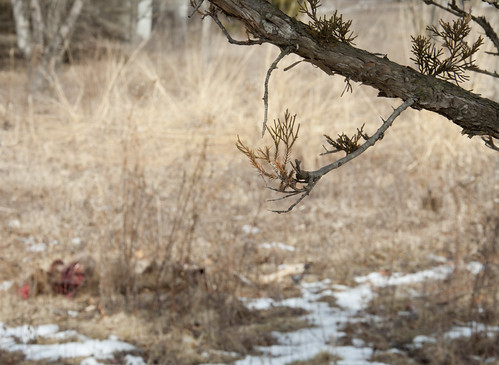
As I drove out, I noticed a dead opossum on the side of the road, near the gardens' entrance, but I decided I'd come back for it later. That afternoon, Steph and I did return, with the intention of simply moving the opossum from the ever-busy Dixboro Road to a more sheltered place. It was a bit more of a trickier operation than I'd bargained for, and it involved crossing a stream and getting whacked in the face by many a thorny branch. I finally reached the opossum, waited (quite a while) for traffic to pass, and grabbed the tail, disappearing back into the underbrush.
The opossum was a huge male, and very heavy. His skull was split, and a tire tread had ripped open his belly. He had a faint, musky smell, the tip of his tail had succumbed to frostbite, and his feet were absolutely fascinating.

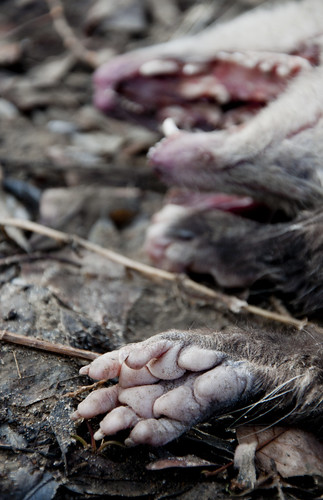
The opossum was a huge male, and very heavy. His skull was split, and a tire tread had ripped open his belly. He had a faint, musky smell, the tip of his tail had succumbed to frostbite, and his feet were absolutely fascinating.


It was so interesting to be able to view this opossum's feet up-close. The whorls on the paw pads looked a lot like human fingerprints, and the front foot even felt a bit like a human hand. Opossums have such specialized feet for climbing and gripping branches; the "thumb" on the back foot was a bit of a surprise!
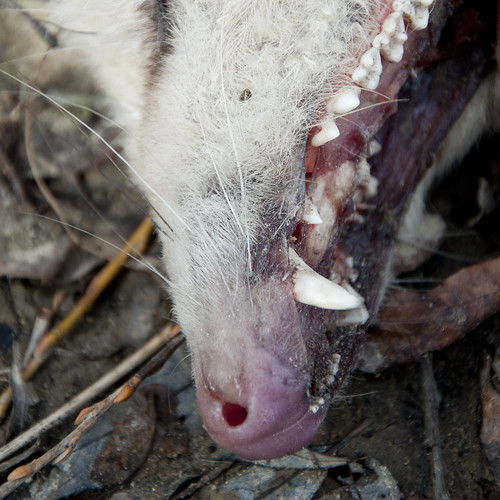

Like many roadkill opossums I've encountered, this individual's mouth was wide open, exposing his very sharp and numerous teeth. One canine had been crushed when he'd been hit, but the rest were present. Opossums have a pretty bad reputation, and I'm guessing it has a lot to do with their naked, rat-like tails and their pointy, seemingly endless number of teeth. They're North America's only marsupial, and they've gradually moved north into Michigan. Opossums didn't originally live in such cold areas, and their naked toes and tails often suffer because of this northern migration.
We left the opossum's body near the bank of the stream; it will decompose in a more dignified place, and it will be scavenged in a far safer area.
As we studied the many animal tracks in the mud near the water -- we identified raccoon, muskrat, and mink prints -- a flash of white caught my eye. It was another raccoon skull poking up through the leaf litter, not far from where I'd found the raccoon skeleton on Thursday.
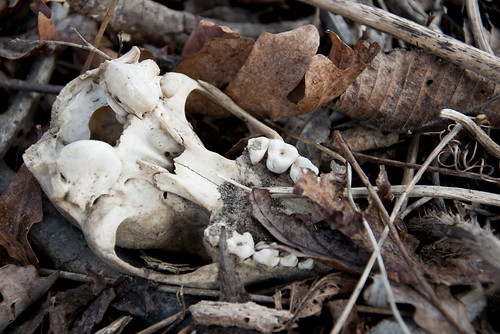
We left the opossum's body near the bank of the stream; it will decompose in a more dignified place, and it will be scavenged in a far safer area.
As we studied the many animal tracks in the mud near the water -- we identified raccoon, muskrat, and mink prints -- a flash of white caught my eye. It was another raccoon skull poking up through the leaf litter, not far from where I'd found the raccoon skeleton on Thursday.

We found many bones, resting both atop the leaves and in the dirt. This was another young animal; the ribs were tiny and the vertebrae were not fully fused. As we drove home, Steph made a discovery that was at first alarming -- something was inside the braincase! I feared the worst, thinking it was a spider egg case, but whatever it was seemed far too woolly and hairy to belong to a spider. We decided it was probably a moth cocoon, and a quick internet search matched exactly with what is inside the skull. Right now, we're keeping the raccoon skull inside a bugbox, with the hope that the tussock moth will emerge.
I hope to follow up on this interesting re-purpose, and will definitely take some photographs. What a neat use for a skull!
I hope to follow up on this interesting re-purpose, and will definitely take some photographs. What a neat use for a skull!

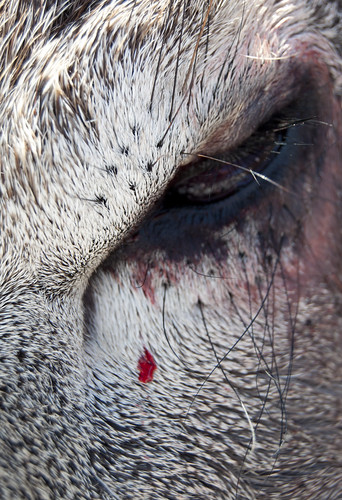



No comments:
Post a Comment